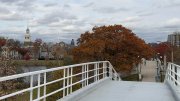Of the $30 million that David Rockefeller has donated to arts education, $25 million will underwrite study centers on the fifth and sixth floors of the new Harvard Art Museum. These three rooms (one for each of the named collections) will allow students and faculty members to request artworks from storage and study them at close quarters.
The present study centers, in the Mongan Center of the Fogg Museum and on the third floor of the Busch-Reisinger Museum, are primarily for works on paper. The new rooms will offer not only access to more of Harvard’s collection (though some pieces, such as large paintings, will probably remain off-limits), but also a chance for visitors to compare works of art from all three museums in a single room. “It’s almost like people can come in and curate their own little show,” says Emily Hankle, a study-room supervisor in the Mongan Center.
Thomas W. Lentz, Cabot director of the Harvard Art Museum, describes the study centers as integral to the museum’s educational mission, on a footing with the gallery space itself. “The prominence we’re giving study centers is going to make this museum different,” he says. Lentz knows from experience just how valuable the opportunity to see art up close can be. As a Harvard doctoral student in the early 1980s, he decided to specialize in Persian art in part because, on visits to the Islamic department, he was able to scrutinize the paintings he studied. He kept those experiences in mind when planning the new museum. “With great works of art, and through great works of art,” he explains, “we can teach in ways that others can’t.”









